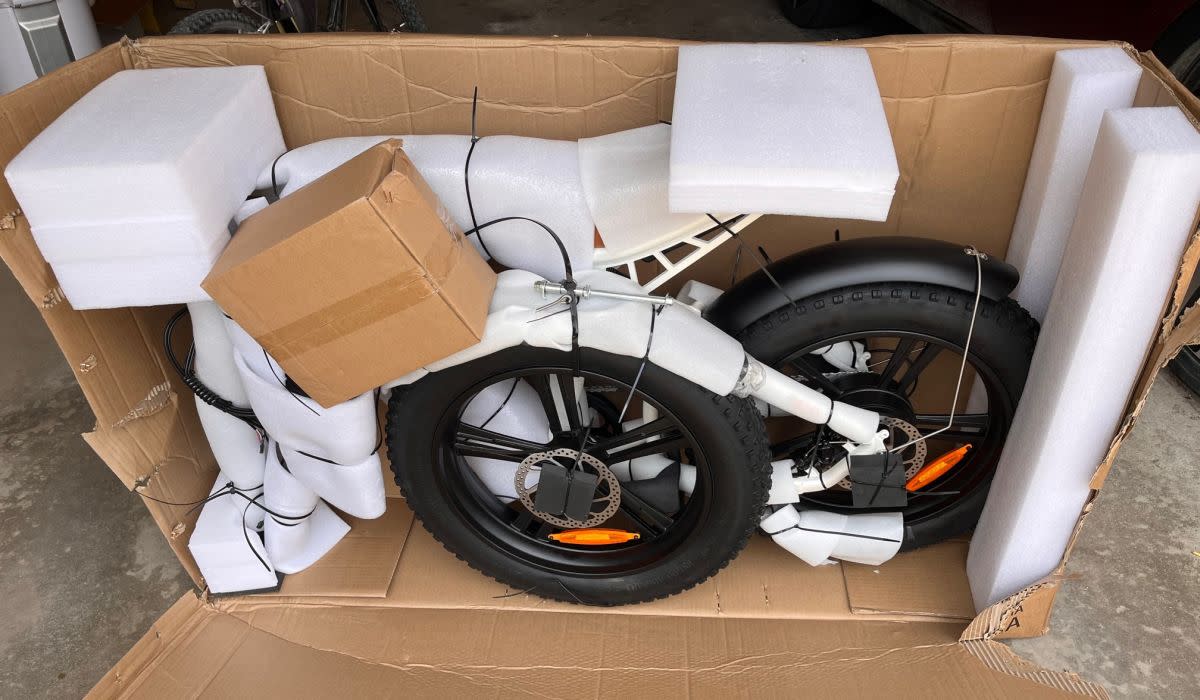I tried the Engwe M20 offroad e-bike: It's sexy and affordable, but far from perfect
E-bikes are all the rage right now, and with good reason: They're fun to ride and decidedly practical if you're looking for an environmentally friendly way to commute. Of course, some bikes also let you venture off-road, with big, knobby tires that can take to the trails. The Engwe M20 falls into that category, with a motocross-style design that practically begs for dirt roads. It's a kissing cousin to the popular Super73 bike, which costs considerably more. Indeed, at $1,299 for the single-battery model and $1,599 for the two-battery (which I tested), the M20 feels like a serious bargain. But what's it like to ride? And would I recommend buying it? Here's my Engwe M20 review.
The Engwe M20: Design and assembly
Available in black, green or white, the M20 is a looker. With its stacked dual headlights, 20-inch fat tires and long leather seat, it looks more like a motorcycle than a bike; only the pedals give it away. This thing has style points through the roof.
Of course, that's after it's built. The M20 comes partially assembled; it's up to you to attach the headlights, handlebars, pedals, front fender and front wheel. That doesn't sound too bad, right? It wouldn't be, except that Engwe's instruction manual is woefully incomplete — and just plain in inaccurate in places. For example, one of the first steps shows which of three included Allen wrenches to use on the handlebar mount — but it's the wrong one.
All told, it took me over an hour to finish assembly, starting with cutting loose several million (okay, dozen — seemed like more) zip ties. Most of my time was spent figuring out the front wheel installation, which is confusing at best. It didn't help that I had to use my own adjustable wrench to tighten the wheel shaft, which has different size nuts on either end. Although Engwe supplies three wrenches, none of them fit the second of those two nuts.
The manual does a better job explaining the bike's instrument panel, which displays things like speed, distance, battery life, pedal-assist setting and so on. But there's almost zero information regarding the batteries themselves: how to charge them, how to attach or remove them, even just how to turn them on. (You might think it's the little power button on the front, just below the LED status lights. Nope; it's the little red switch on the side.)
What's more, this version of the bike came with two batteries, which is great: It allows for a range of nearly 70 miles (!) if you don't pedal and almost 95 miles if you do. But should you just turn on one and leave the other in reserve? Or use both simultaneously, all the time? Again, no help from the manual, but I managed to locate answers to these questions in Engwe's FAQ section. Neither source offered help with issues like a front wheel rubbing against the brake.
For anyone who's comfortable with bikes, or at least mechanical things, these issues may not be a big deal. There's not much here that can't be figured out through trial and error. But for novices or non-handy types, the lack of good documentation is a problem. (After I explained this to an Engwe representative, I was told a tutorial video had just been uploaded to YouTube. It definitely helps, but you still might want to enlist a bike shop to help you with the build.)
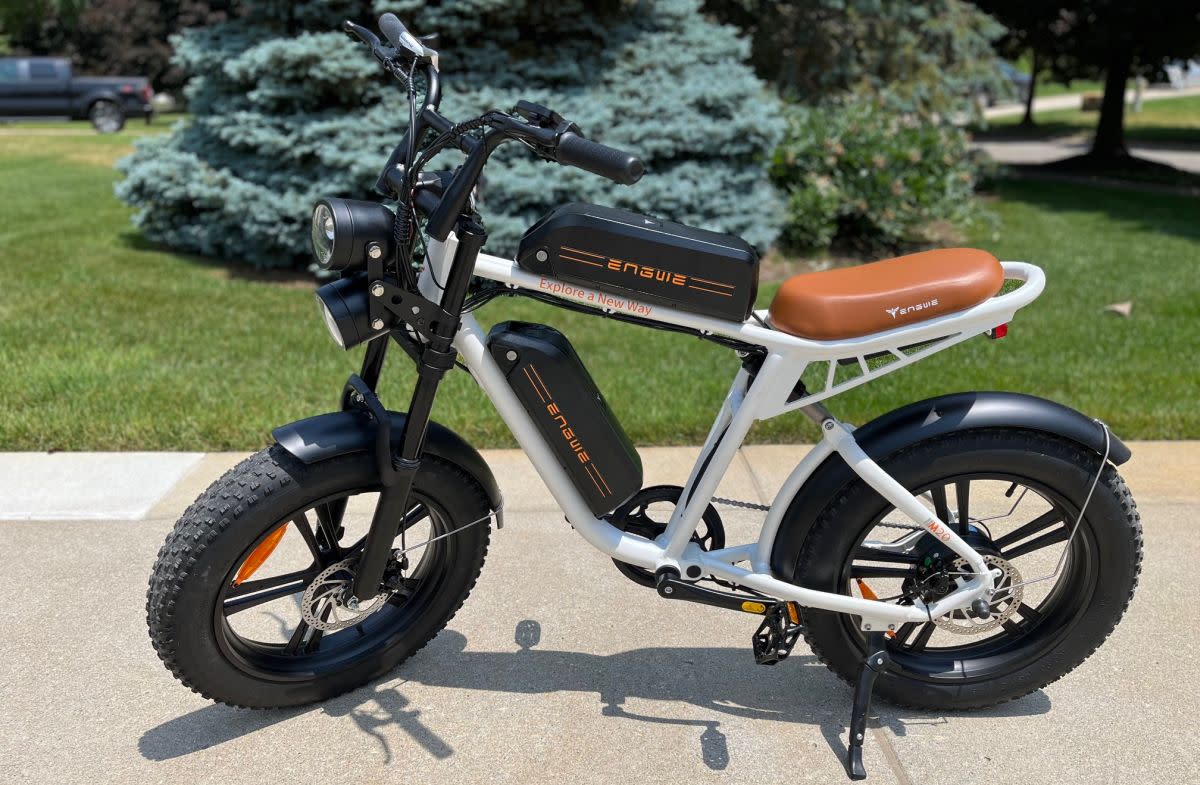
The Engwe M20 features and fit
The M20, a Class 3 bike, features a 750-watt motor offering a maximum speed of 28 miles per hour — though I never saw it get past around 25 mph unless I was on a downward grade. It has front and rear shock absorbers (the former user-adjustable) promising a smooth ride and a leather seat that's longer and cushier than most.
That's the good news; the bad news is the seat isn't height-adjustable, meaning for anyone in the ballpark of my size (6' tall), pedaling is awkward at best. To my thinking this is less of a bike and more of a moped, which may be fine depending on your needs. Personally, I want a bit of exercise when I ride, but my knees practically touch my chest when I pedal. It's not comfortable; in fact, it makes riding feel unsteady, especially when the motor kicks in.
Speaking of which, like a lot of e-bikes, this one relies on a cadence sensor that detects when you're pedaling, then engages the pedal-assist system (PAS). This can be great when, for example, you're riding up a hill; the motor activates to make things easier. However, there's considerable sensor-lag: You have to pedal for several seconds before anything happens, and then pedal assist gooses the motor to whatever PAS speed setting is selected (1-5). This feels weird and actually rather scary at first, like the bike is running away with you.
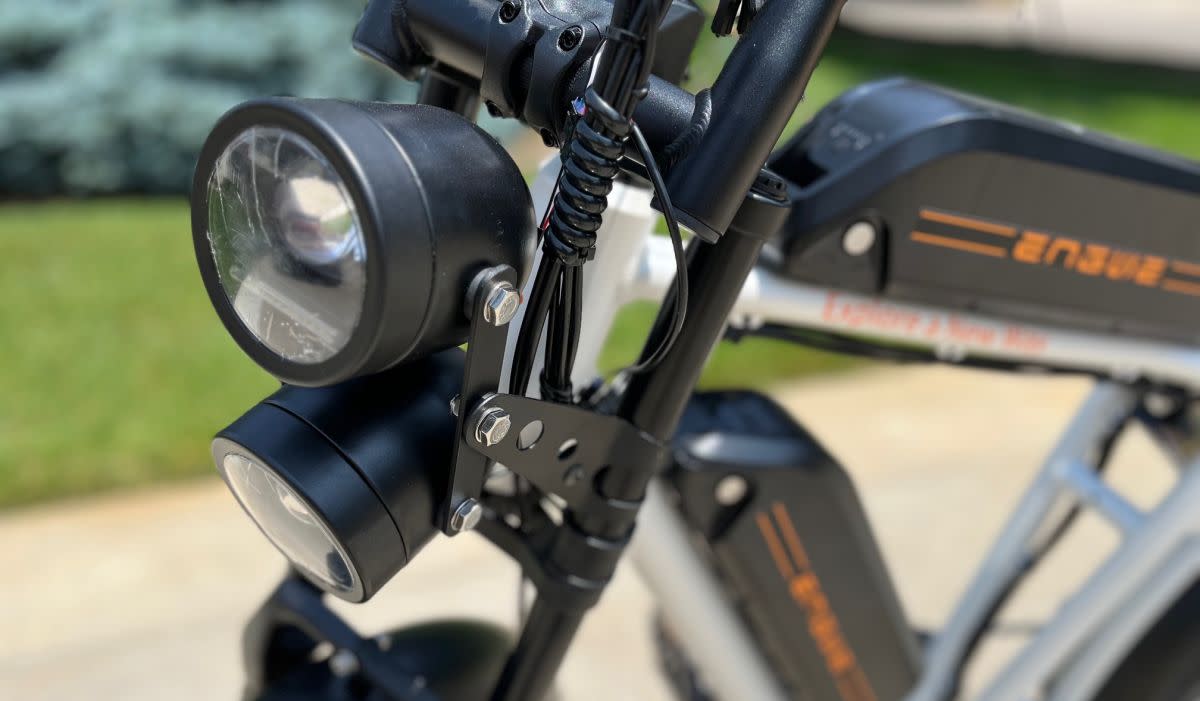
It's also a huge letdown when you're at a standstill and want to get moving quickly, like to cross a street. You really have little choice but to rely on the throttle; the sensor lags too much, and the bike is too heavy to get it going on your own. The sensor also waits a bit too long for my liking to disengage the motor after you stop pedaling; it should happen instantaneously, but here it often continues for a couple seconds.
On the subject of the throttle, it's a motorcycle-like twisting hand-grip. Cool, yes, but take note that it's really just a toggle switch: The motor is either engaged or it's not. Anyone expecting a variable-speed system like on a motorcycle will be disappointed. Your actual speed is dictated by whatever PAS setting you've selected.
I like the bike's dual headlights — you can angle one straight ahead and another down to better light your path — and electronic horn, both activated by conveniently positioned handlebar buttons. I also like the always-lit tail light that gets brighter when you hit the brakes. Weirdly, though, the protective plastic sheets on the headlamps simply wouldn't come off, a problem I've seen noted elsewhere.
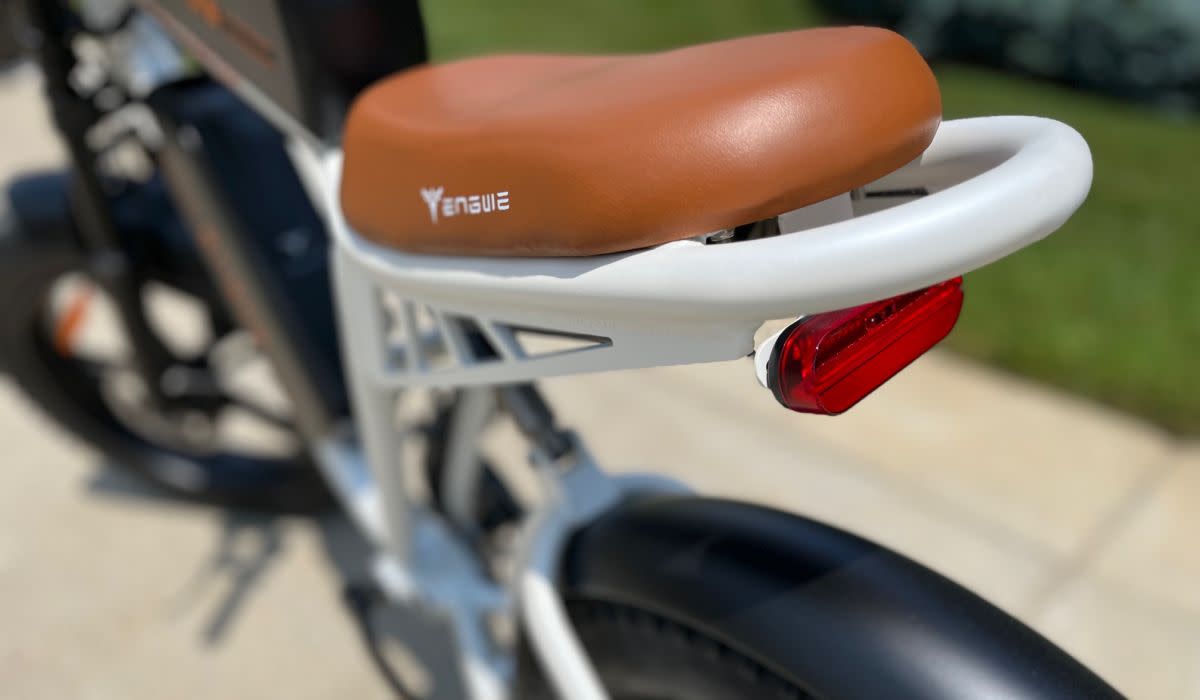
The Engwe M20 on the road
I rode the M20 all over town, on flat, paved paths, grassy road shoulders and offroad trails. I thought it would be a little more comfortable given the long saddle and rear shock-absorber, but I felt a lot of the bumps, and after about 20 minutes my bum started wishing for more cushioning. What's more, although it sounds counter-intuitive, the low seat made me feel like I had less control over the bike, especially on steep downward grades.
In fact, I always thought I was something of a thrill-seeker, but it turns out I preferred when the PAS was set to just 1 or 2; anything faster felt a little too fast. That was especially true when pedaling on flat terrain; I didn't like how the motor seemed to overtake my feet, how it pushed to full power within just a couple seconds. You can't be leisurely on this bike, not unless you turn PAS off and rely solely on pedal power.
I should also note that the M20 is heavy: 77 pounds. When I let myself get going fairly fast on a decline, I found I had to squeeze the brake levers pretty hard to get the mechanical disc brakes to slow me down. This kind of braking system is to be expected in a bike starting at $1,300, but hydraulics would certainly be preferable here given the weight.
And it's because the bike is so heavy that I couldn't really get comfortable riding it on single-track dirt trails, where you often need to brake quickly, make sharp turns and get up in the saddle. While the M20 is fine on gravel and dirt roads, it's too cumbersome for real trail riding.
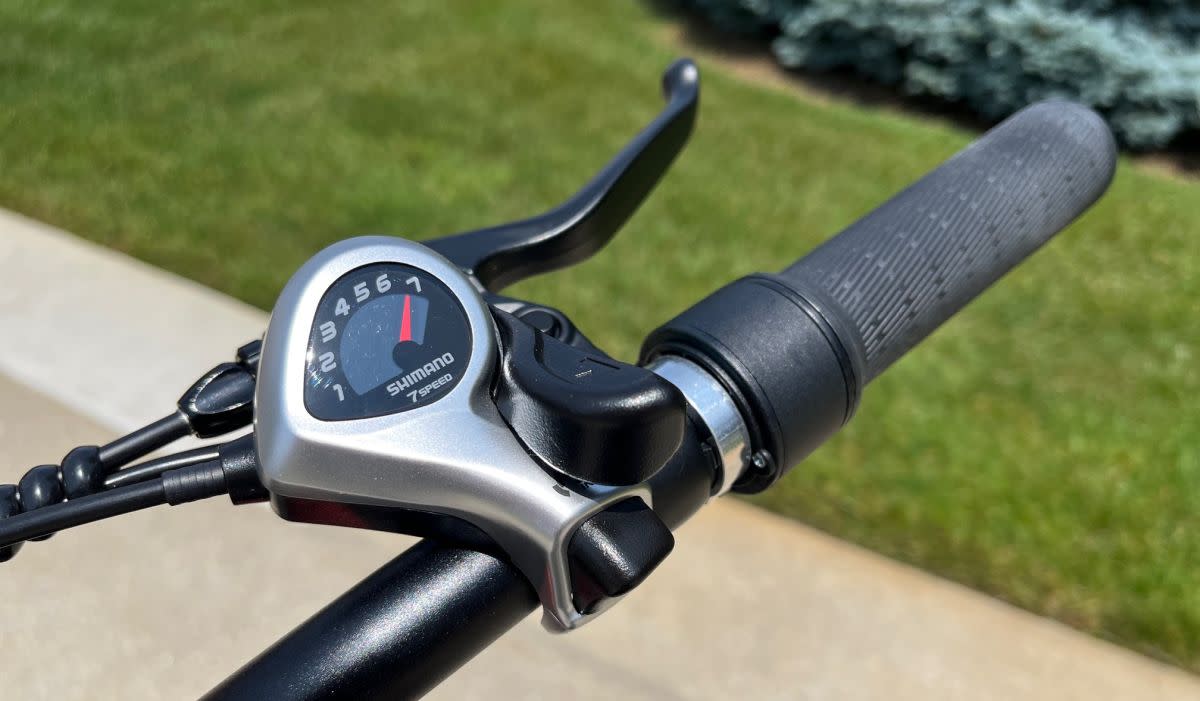
There's some good news here, though. Once you get accustomed to the way it accelerates (and brakes), the M20 is pretty fun to ride. It can handle fairly steep hills without breaking a sweat; there were times I thought sure I'd have to start pedaling, but the motor did the heavy lifting. The fat, knobby tires glide over all kinds of terrain with ease; you don't have to worry about cracks in the pavement or steep curbs. And although you can't see the bike while you're riding it, it sure does look pretty parked in your garage.
Regarding range, you should always take manufacturer's claims with a grain of salt. Could the two-battery M20 really carry you 70 miles if you just laid on the throttle the entire time? Maybe — if you weigh 50 pounds and there's a strong wind at your back. There are lots of variables that can impact range: terrain, rider weight, wind resistance and so on. I wasn't able to do a full-on range test, but I can tell you this: I weigh 180 pounds; I rode the bike about six miles with one battery turned on, and that brought its capacity down to about 80 percent. In theory, then, I might get about 30 miles under the same conditions, or 60 with both batteries.
Your mileage may vary, quite literally. Even if you were to get 40-50 miles, that's pretty impressive range for any e-bike, let alone one this heavy. The two-battery option is a must for anyone looking to travel longer distances. (That said, this configuration leaves no room for any kind of storage. You could maybe mount a small water bottle holder to the vertical seat post, but that's about it.)
Engwe M20 verdict: Should you buy it?
I'm not exactly sure who this bike is for. Although the two-battery model offers impressive range, I don't think it's a practical commuter bike. It's not really nimble enough for city use, and heaven help you if you need to carry it up or down any stairs. (Unless you're The Rock, I wouldn't try.)
It's not good for exercise, either; the seat is too low for comfortable pedaling and can't be adjusted. It's also set back farther than a normal bike seat, resulting in less control when you're on steep or uneven terrain. The handlebars are fixed-height as well, which can also contribute to comfort issues.
What's left, then, is an offroad moped that's just... for fun? Once you dismiss the idea that this is a bike, you can more fully appreciate the M20's merits. It's fast and stable, able to traverse nearly any terrain, with dual headlights and a brake light for safety. It's solidly built and mostly comfortable to ride. And it's priced far below many competing bikes, something to consider if you like the style (which is dazzling) but don't have a big budget.

